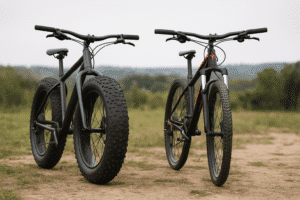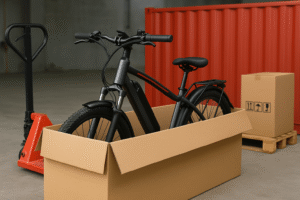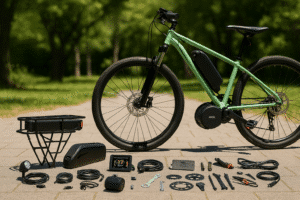Electric bikes have motors, so it’s easy to think they count as motorized vehicles.
But legally, that’s not always the case. Whether your e-bike is treated like a car or a regular bicycle depends on its speed, motor power, and where you ride.
TL;DR
In most places, an electric bike isn’t classified as a motorized vehicle if it has pedals, a motor under 750 watts, and a top assisted speed of 20–28 mph. That means you can usually ride without a license, registration, or insurance, though local laws can vary.
What Exactly Is an Electric Bike?
An electric bike, or e-bike, is a bicycle with a small motor that helps you pedal—but you still need to do some of the work. It’s not like a motorcycle or scooter that runs entirely on power. Think of it as a regular bike that gives your legs a helpful push, especially on hills or longer rides.
Most e-bikes come with a battery, a small motor, and a controller that adjusts how much help you get. Some have a throttle, so you can cruise without pedaling, while others only assist when you’re actually pedaling.
There are different classes of e-bikes, too—Class 1 and 2 usually go up to 20 mph, while Class 3 can reach 28 mph with pedal assist.
Whether you’re commuting, doing food delivery, or just riding for fun, the electric assist makes biking easier and more enjoyable—without completely replacing the need to pedal.
Is an Electric Bike a Motorized Vehicle?
No, an electric bike is not considered a motorized vehicle under most laws—if it meets certain conditions. In general, e-bikes are treated more like bicycles than motorcycles or mopeds.
Here’s where it gets a bit tricky: the rules can vary depending on where you live. At the federal level in the U.S., as long as the e-bike has pedals, a motor no more than 750 watts, and a top speed under 20 mph (on throttle) or 28 mph (on pedal assist), it’s not classified as a motor vehicle.
That means you don’t need a license, insurance, or registration. But states and cities can have their own rules, so it’s always worth checking your local laws.
What Counts as a Motorized Vehicle?
A motorized vehicle is usually any vehicle powered by an engine or motor that runs without human pedaling or pushing. This includes cars, motorcycles, mopeds, and scooters.
The key thing that separates e-bikes from motorized vehicles is how the motor is used. Most e-bikes require you to pedal—at least a little bit. That keeps them in the “bike” category. True motorized vehicles, on the other hand, don’t need human input to move forward.
They’re also more powerful. Cars and motorcycles are built to go much faster and need to follow a whole set of safety and licensing rules. E-bikes, by comparison, are limited in speed and motor strength, which is why they’re usually regulated more like bicycles.
How E-Bike Regulations Differ from Motor Vehicle Rules

E-bikes are a lot more flexible when it comes to legal requirements. Here’s how they differ:
- No license or registration required: As long as your e-bike meets the local class guidelines, you don’t need a driver’s license or to register it like a car or motorcycle.
- No insurance needed: You’re not legally required to carry liability insurance (though some riders choose to anyway for peace of mind).
- Bike lane access: Most e-bikes can use bike lanes, paths, and shared-use trails—unless local rules say otherwise, especially for faster Class 3 e-bikes.
- Helmet laws vary: Some places only require helmets for riders under a certain age or for Class 3 e-bikes.
- Speed limits apply: Class 1 and 2 e-bikes are capped at 20 mph, while Class 3 can go up to 28 mph (pedal assist only). Anything faster usually puts you in a different category.
- No emissions checks or road taxes: E-bikes don’t require the same vehicle inspections or taxes as cars and motorcycles.
E-Bike vs. Motorized Bike, Moped, and Motorcycle
It’s easy to mix up e-bikes with other two-wheeled rides like mopeds or small motorcycles. But they’re not the same when it comes to how they work—and how they’re treated by law.
Here’s a quick comparison to clear things up:
| Type | Pedals Required | Top Speed | Motor Power | License/Registration Needed | Legal Category |
|---|---|---|---|---|---|
| E-Bike (Class 1/2) | Yes (pedal assist or throttle) | 20 mph | Up to 750W | No | Bicycle |
| E-Bike (Class 3) | Yes (pedal assist only) | 28 mph (with pedaling) | Up to 750W | No | Bicycle (with restrictions) |
| Motorized Bike | Sometimes | 20–30 mph | 750W+ or gas engine | Often Yes | Motorized vehicle |
| Moped | No | 30–40 mph | Small gas/electric motor | Yes | Motor vehicle |
| Motorcycle | No | 100+ mph | High‑power engine | Yes | Motor vehicle |
Access to Public Roads, Trails, and Parks
Where you can ride your e-bike really depends on its class and your local rules. Most Class 1 and Class 2 e-bikes are allowed on bike lanes, shared-use paths, and regular roads.
Class 3 e-bikes, which are faster, might be restricted from certain bike paths or trails, especially those shared with pedestrians.
If you’re hoping to take your e-bike into parks or natural areas, you’ll want to double-check the rules first. The National Park Service does allow e-bikes on many park roads and bike paths, but some trails still have restrictions—especially for higher-speed or throttle-powered bikes.
I’ve personally run into different rules from city to city. Some towns are super e-bike friendly, while others still treat them with caution.
When in doubt, check your city or park’s website or just ask a ranger or local bike shop.
Final Words
So, is an electric bike a motorized vehicle? Not usually. As long as it has pedals, stays under 750 watts, and keeps its speed under 20–28 mph (depending on the class), it’s considered a bicycle—not a motorized vehicle. That means no license, no insurance, and way more flexibility.
Here’s the short version:
- E-bikes give you motor help but still need human pedaling.
- They’re legally treated like bicycles in most places—not cars or motorcycles.
- Rules can vary, especially on trails and in parks.
- And just because they’re not motor vehicles doesn’t mean you can ignore safety or local laws.
At the end of the day, e-bikes are a practical, fun, and accessible way to get around. Just know your bike’s class, follow the local rules, and ride with respect.
FAQs
Is an electric bike considered a vehicle?
Yes, but not in the same way as a car or motorcycle. It’s usually classified as a bicycle with a motor, not a motor vehicle.
Can e-bikes go on motor vehicle roads?
In most areas, yes. E-bikes can ride on regular streets just like traditional bicycles. But stick to the right lane and follow traffic rules.
Do you need a license to ride an e-bike?
Nope—not for most e-bikes (Class 1, 2, or 3) as long as they meet local legal definitions. Higher-powered models might be different.
What’s the difference between an e-bike and a moped?
E-bikes usually need pedaling and go slower. Mopeds run on gas or higher-power motors, don’t require pedaling, and often need a license.
Are e-bikes allowed on bike trails?
Usually, yes for Class 1 and 2. Class 3 e-bikes may be restricted from some trails or paths, especially shared-use ones. Always check the signs or local rules.
Michael Josh is a hands-on e-bike tester and reviewer at BoltBikers, known for putting every model through real-world rides before sharing his thoughts. With a sharp eye for performance, comfort, and build quality, he helps the team choose which bikes are worth featuring. Backed by years of experience in tech and gear reviews, Michael brings trusted, honest insights to help readers find the right e-bike for their needs.








